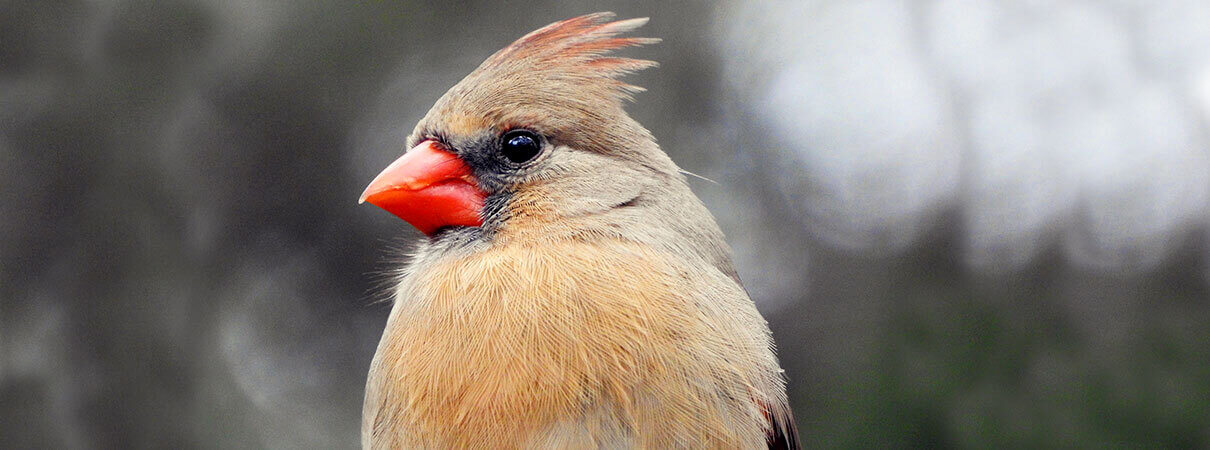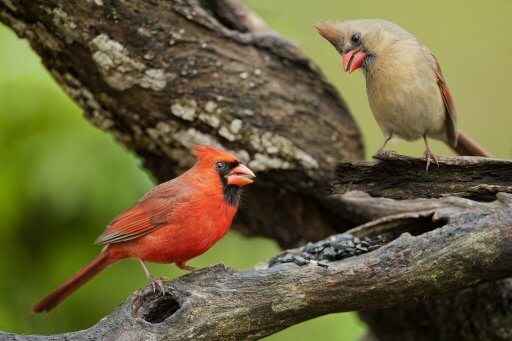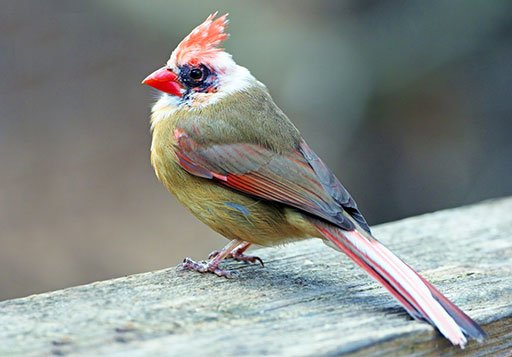Backyard Beauty: Surprises and Secrets of Female Cardinals
It's easy for bird lovers to develop a bit of tunnel vision when it comes to male birds — after all, they tend to have brighter colors and more dazzling songs than their female counterparts. But female birds are fascinating, too, and just as deserving of our attention and admiration.
One of the most easily recognizable female birds in the backyards of eastern, central, and southwestern North America is the female Northern Cardinal, and it's time we gave her the recognition she's due!

Female Cardinals' Subtle Beauty
Although lacking the brilliant red plumage of the male, the female cardinal has an elegant beauty all her own, with a warm, buffy tan color over her back, breast, and sides; red-orange on the wings, tail, and crown; and a blackish “mask.” Female cardinals also have a crest and a chunky red-orange bill, traits they share with males.

You can easily distinguish adult males and females by color: In contrast to the female's muted plumage, males are bright red birds. (Northern Cardinals get their name from this color, which reminded early European settlers of a Catholic cardinal's red robes.) Females are also slightly smaller than males on average, although the difference is subtle.
Just after fledging, juvenile male and female cardinals look alike. Both look like duller versions of adult females, with a gray or black bill, a shorter crest, and lack of the adult female's red-orange highlights. While birds molting out of juvenile plumage and splotched with red can be identified as males, birds with dark bills and “female-like” plumage are not distinguishable as male or female.
Depending on where you live, it is not rare to see a female cardinal. The Northern Cardinal is one of North America's most abundant bird species and is found year-round throughout the eastern and central U.S., in the desert Southwest, across much of Mexico, and even in northern Guatemala and Belize.
In recent decades, its range has crept northward, through New England and into southeastern Canada. This bird has also been introduced to Hawai`i and Bermuda.
Males and Females Working Together

Male and female cardinals work together to select and defend the territories where they'll nest and raise their young. They display to each other during courtship, performing a variety of twisting, swaying, and chest-puffing movements. Although males help choose where the nest will be built, females handle the actual nest construction and incubate the eggs.
Male cardinals feed females when courting them and again when the female is incubating and can't forage for herself. To request food, the female cardinal begs the same way a young bird would, opening her bill and fluttering her wings.
Singing Is Key Both for Male and Female Cardinals
Contrary to the idea that only male birds are good vocalists, female cardinals do in fact sing. Males typically sing more often, more loudly, and from higher perches, but both sexes break into song to defend their shared territories.
Males also sing to females during courtship, and pairs sing duets together when preparing to nest. When a female is incubating or caring for newly hatched chicks, she sometimes sings from the nest to communicate with the male, likely signaling when to bring food and when to stay away to avoid predators.
Male and female cardinals sing the same types of songs, usually consisting of repeated phrases that sound like “cheer, cheer, cheer” or “birdy, birdy, birdy.” You can listen to a male and female duetting in the recording below:
Cardinal Relationships: Bonded, but not Always for Life
Male and female cardinals don't necessarily mate for life. Although pairs may stay together for multiple years, they do sometimes seek out new mates. One study of a cardinal population in Ohio found that 20 percent of pairs separated during the breeding season and 10 percent more split up over the winter.
Odd-looking Cardinals

Some cardinals break the standard “brown females, red males” color mold.
Leucistic cardinals lack pigment in their feathers and may sport a few white patches or be almost entirely white with a rosy tinge to their crests, wings, and tails. (Leucistic birds have some color; they're not technically albino.)
Scientists and birdwatchers have also documented a few male cardinals that are yellow instead of red due to a rare genetic mutation.
But that's not all. Very rarely, cardinals can also be hermaphrodites — that is, half male, half female.
Specifically, a few cardinals have been documented to be a special kind of hermaphrodite called a “bilateral gynandromorph.” The genders of these birds are literally split down the middle: One side of the body is male and has red feathers, the other side is female and has tan-brown feathers. This unique condition has been documented in other bird species, as well as in butterflies and crustaceans.

Biologists have come up with a few theories to explain its occurrence. One possibility is that a bilateral gynandromorph starts out as two separate embryos, one female and one male, that fuse during development. Another is that a female inadvertently produces an egg carrying copies of both of her sex chromosomes, instead of just one, which is then fertilized by two separate sperm. (Female birds have two different sex chromosomes, labeled Z and W.) The split down the middle is just a byproduct of the symmetrical way that vertebrates develop.
Hermaphroditic cardinals are exceedingly rare, so if you're lucky enough to spot one, be sure to take a photo. A Northern Cardinal that was female on the left and male on the right was spotted in Pennsylvania in 2019 and again in 2021 (probably the same bird both times).
Biologists think these unique birds are probably infertile, but the one in Pennsylvania was observed being courted by a male. A female bird typically has one functioning ovary on the left side, the side that was female in the Pennsylvania bird. However, the result of this courtship, if any, remains unknown.
Northern Cardinal Populations
Northern Cardinal numbers have grown by more than 15 percent since 1970, bringing the U.S. and Canada breeding population to an estimated 110 million. This increase has been linked to this species' ability to successfully adapt to human-dominated environments.
While Northern Cardinals are doing well, many other birds have fared poorly during this period of environmental change.
The combined impact of invasive species, window collisions, habitat loss, and pesticide use, among other things, has contributed to staggering population losses in many species. Over the last 50 years, North American bird populations have declined by 2.9 billion birds. This stunning decline accounts for nearly 30 percent of all birds in the United States and Canada.
American Bird Conservancy and other conservation groups are working to reduce threats and help bird populations rebound. Learn more about how you can get involved and live a bird-friendly life.


















































